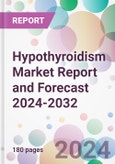Hypothyroidism Market Outlook
The hypothyroidism market size was valued at USD 2.1 billion in 2023, driven increasing prevalence of hypothyroidism in the 7 major markets. The market size is anticipated to grow at a CAGR of 4.60% during the forecast period of 2024-2032 to achieve a value of USD 3.3 billion by 2032.Hypothyroidism: Introduction
Hypothyroidism is a common endocrine disorder where the thyroid gland doesn't produce enough thyroid hormone. It often leads to reduced metabolism, causing symptoms like fatigue, weight gain, cold intolerance, and depression. Women and older adults are more commonly affected. Diagnosis is typically based on blood tests measuring thyroid-stimulating hormone (TSH) and thyroxine (T4) levels. Treatment primarily involves hormone replacement therapy with synthetic thyroxine (levothyroxine), tailored to individual needs, and regular monitoring to ensure proper dosing.Key Trends in the Hypothyroidism Market
There's a growing awareness and diagnosis of thyroid disorders, including hypothyroidism, partly due to better screening and recognition of symptoms. This trend is increasing the patient pool requiring treatment.Although levothyroxine remains the standard treatment, there's ongoing research into more effective and personalized treatment options, including the development of therapies that mimic the natural diurnal rhythm of thyroid hormone levels.
There's a trend towards personalized medicine in treating hypothyroidism, with dosages of medications like levothyroxine being tailored based on individual patient needs, considering factors like age, weight, and the presence of other health conditions.
Digital health technologies, including mobile apps and wearable devices, are becoming more integrated into patient care, aiding in better monitoring of symptoms and treatment adherence.
There is an increasing emphasis on patient education, empowering individuals to manage their condition effectively, recognize symptoms, and understand treatment regimens. Regulatory agencies have been focusing on ensuring the quality and efficacy of thyroid hormone replacement therapies, leading to stringent guidelines and monitoring.
The market is expanding in emerging economies due to improving healthcare infrastructure, increasing healthcare spending, and rising awareness about thyroid disorders.
The market is witnessing significant competition, and the availability of generic versions of hormone replacement therapies is influencing market dynamics, often making treatments more accessible and affordable.
Hypothyroidism Market Segmentation
Market Breakup by Drug Class
- Levothyroxine
- Liothyronine
Market Breakup by Route of Administration
- Oral
- Parenteral
- Others
Market Breakup by Distribution Channel
- Wholesale Distribution
- Retail Stores
- Online Pharmacy
Market Breakup by Region
- United States
- EU-4 and the United Kingdom
- Germany
- France
- Italy
- Spain
- United Kingdom
- Japan
Hypothyroidism Market Overview
In North America, the prevalence of hypothyroidism is notably high, primarily driven by lifestyle factors, dietary patterns, and a higher screening rate compared to other regions. The United States sees a significant portion of this market due to increased awareness, well-established healthcare infrastructure, and a focus on early diagnosis and treatment. Canada follows a similar trend, with both countries showing a robust adoption of advanced treatment options and a growing emphasis on personalized medicine. Public health initiatives promoting thyroid health and regular check-ups contribute to the market dynamics in this region.Europe exhibits a strong focus on hypothyroidism management, with countries like the United Kingdom, Germany, and France leading in terms of patient awareness and healthcare provision. The region benefits from widespread healthcare access, high-quality medical facilities, and comprehensive insurance coverage, supporting timely diagnosis and treatment. European markets are also characterized by active engagement in research and development activities, leading to innovative treatment approaches and thyroid hormone replacement therapies. Additionally, the aging population in Europe contributes to the demand for hypothyroidism management solutions.
Japan represents a unique market for hypothyroidism treatment, characterized by a high degree of healthcare sophistication and a rapidly aging population. The country exhibits a strong propensity for early screening and diagnosis, coupled with a preference for cutting-edge treatment options. Japanese healthcare providers emphasize meticulous patient monitoring and follow-up, ensuring optimal treatment outcomes. The market is further supported by government initiatives focusing on thyroid disorders and public awareness programs, which help in early detection and management of hypothyroidism.
Hypothyroidism Market: Competitor Landscape
The key features of the market report include patent analysis, grants analysis, clinical trials analysis, funding and investment analysis, partnerships, and collaborations analysis by the leading key players.- AbbVie Inc.
- Merck & Co.
- Lannett Company, Inc.
- Allergan plc
- Mylan N.V.
- GlaxoSmithKline plc
- Novartis AG
- RLC LABS
- Abbott Laboratories
- Viatris
- Elexis
- IBSA Pharma
- Amgen
- Fresenius SE and Co.
This product will be delivered within 5-7 business days.
Table of Contents
1 Preface
3 Hypothyroidism Overview
4 Patient Profile
5 Hypothyroidism Epidemiology Analysis - 7MM
6 Hypothyroidism Market Overview - 7MM
7 Hypothyroidism Market Landscape - 7MM
8 Hypothyroidism Challenges and Unmet Needs
10 Hypothyroidism Market Dynamics
11 Hypothyroidism Market Segmentation - 7MM
12 United States Hypothyroidism Market
13 EU-4 and United Kingdom Hypothyroidism Market
14 Japan Hypothyroidism Market
15 Patent Analysis
16 Grants Analysis
17 Clinical Trials Analysis
18 Funding Analysis
19 Partnership and Collaborations Analysis
20 Supplier Landscape
21 Hypothyroidism Market - Distribution Model (Additional Insight)
23 Company Competitiveness Analysis (Additional Insight)
24 Payment Methods (Additional Insight)
Companies Mentioned
- AbbVie Inc.
- Merck & Co.
- Lannett Company Inc.
- Allergan plc
- Mylan N.V.
- GlaxoSmithKline plc
- Novartis AG
- RLC LABS
- Abbott Laboratories
- Viatris
- Elexis
- IBSA Pharma
- Amgen
- Fresenius SE and Co.
Methodology

LOADING...
Table Information
| Report Attribute | Details |
|---|---|
| No. of Pages | 180 |
| Published | February 2024 |
| Forecast Period | 2024 - 2032 |
| Estimated Market Value ( USD | $ 2.3 Billion |
| Forecasted Market Value ( USD | $ 3.3 Billion |
| Compound Annual Growth Rate | 4.6% |
| Regions Covered | Global |
| No. of Companies Mentioned | 14 |









